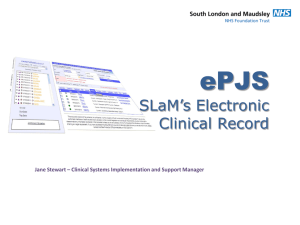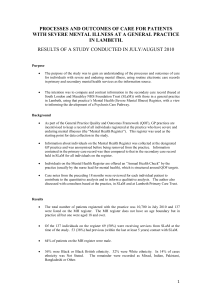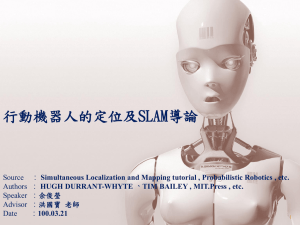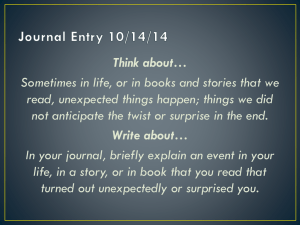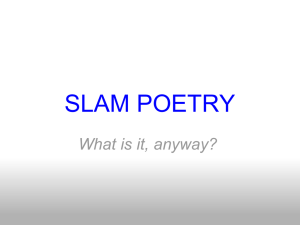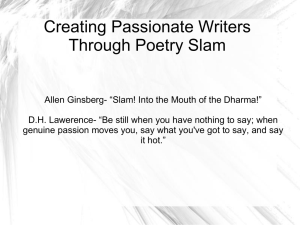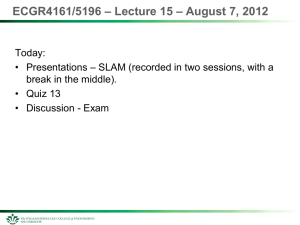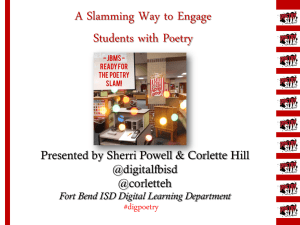A Strategy for SLaM to develop the arts in mental health, wellbeing
advertisement
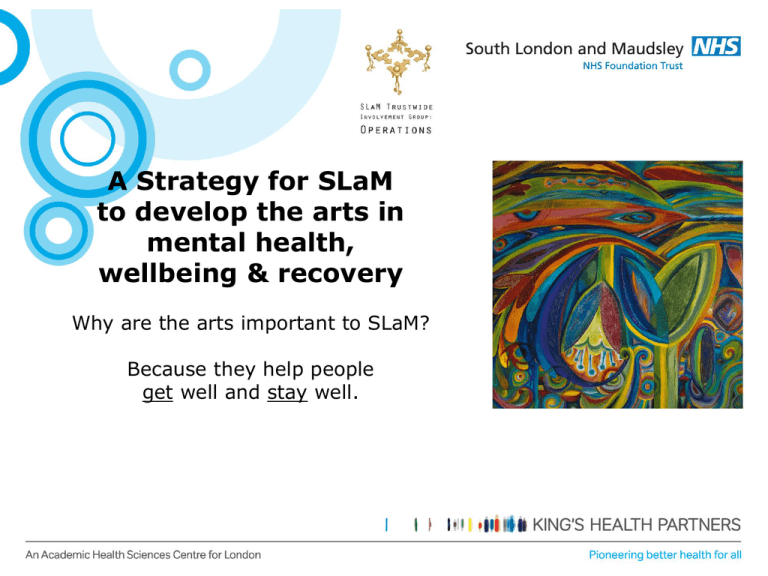
A Strategy for SLaM to develop the arts in mental health, wellbeing & recovery Why are the arts important to SLaM? Because they help people get well and stay well. Key points for the Arts Strategy 1. Identify SLaM’s strengths and weaknesses in the arts, and set realistic and achievable goals 2. Need to raise and sustain awareness Trustwide regarding the power and potential of the arts, with the support of the Trust Executive Our consultation and findings • Consulted extensively with service users and staff / providers, Trustwide • Identified key themes • Conducted in-depth research of current literature and practice Themes from the Service user consultation 1. 2. 3. 4. 5. 6. 7. Therapeutic Creativity Stigma Access Financial Affirmation & Recognition Relationships Evidence related to the SIR Strategy Fostering relationships Social functioning, networks relationships, connecting. “Art as a connector, with and to things other than oneself” (Thou Art) Peer support, belonging, being valued Partnerships: with wider arts world and public and mainstream Enhancing staff & service user involvement, coproduction/ co-design & development Activities that bring people together – exhibitions, events and contemporary art practice Public engagement Enhancing healing environment- shared public space “Allows new spaces in which to be, and new relationships through which to rethink and reconstruct themselves” (Thou Art) Promoting wellbeing Offering treatments Improving social inclusion Improving SU experience Easing/ reducing symptoms Formal treatment by fully trained Arts Psychotherapists- Arts Therapies Peer support, friendships, community, brings people together Creative personal space Occupational Therapy Enhancing control and Empowerment Informal and formal arts activities in SLaM Sense of self: building self esteem; identity; User led arts organisationsworkshops/ events/ activities Connection art & form of spirituality, “flow” (Thou art) Connecting with abilities, learning new skills; Recognition/ value/ Affirmation Expression (words can’t do) & communication Purpose, motivation, focus Transforming illness/ Having time out Improving staff involvement, morale & development Way “to right lives” and “search for substance” and meaningful sense of “I”. (Thou Art) Artist led workshops Workshops in arts institutions, museums, galleries Arts Education & Training: Higher and Further Education Valued role (as artist not a SU) and recognition Rebuilding self esteem and identity as a ‘well person’ and capable Sense of belonging and cohesive communities Feeling involved & ways to get involved Contemporary art as social practice Lead public engagement & MH promotion ie against stigma Outcomes Consultation & content analysis Service user narratives MWIA Thou Art Film & Research Arts Therapies evidenceNICE guidance in psychosis Published research from Academic arts in health Enhancing the healing environment Arts organisations feedback/ evidence PbR/ Honos Expanding horizons and purpose OT & other outcome measures Preserve life stories & experiences SROI (social return on investment) Provide professional platform for showing & appreciating art Public feedback – MH promotion/ challenging stigma Practical support, i.e. mentoring, new roles, tasks Reduction in revolving door Accessible and acceptable Patient experience of mental health services improved through arts. (Picker instit) Context from other drivers • “For a more co-ordinated integrated set of services; we need the workforce equipped for challenges, and improved quality and capacity..” (Exploring our futures in health and social care in Lambeth & Southwark) • “Spending on arts & health is and should be seen as a legitimate, integral part of good health care and good staff management, and entirely appropriate for NHS activity & investment” (DH 2007) • “Lambeth will be a vibrant & creative place to live, work and learn” (Lambeth mental wellbeing programme) • Lewisham values: sense of place, creative economy, creativity & skills, active cohesive communities (Lewisham arts strategy) • “Community connections, reaching across place, interests and identity, are largely untapped assets that can promote wellbeing and address social exclusion” (RSA- The Royal Society for the encouragement of Arts, manufactures & Commerce ) Why should SLaM support this? The Arts Strategy will: 1. Develop SLaM’s existing collective intelligence 2. Improve patient experience 3. Reduce “revolving door care” 4. Attract incoming funding 5. Improve service user involvement 6. Further SLaM’s reputation Example of SLaM’s involvement in the London Creativity & wellbeing week June 2012 • Exhibitions: Bethlem Gallery and SGDP @ IOP • Poetry party at Ladywell Unit celebrating the project on the wards • Training for artists @ The Albany -Jointly delivered by SLaM & Lewisham Education Arts Network (LEAN), commissioned by Lewisham Council • Showcase of music produced by service users from Camden and SLaM, with Key Changes and Raw Sounds • Seminar on arts in health and commissioning @ Tate Modern: presenting SLaM arts strategy • CoolTan Arts events SLaM's strengths in the arts in mental health 1. Formal treatment by fully trained Arts Psychotherapists 2. Range of formal/ informal arts activities in SLaM 3. High level of community arts activities run by arts and service user providers 4. Strong links to involve service users in arts training and education 5. Motivated wide network of “activators” and engaged external partners 6. Well-established ethos & practice of service user involvement and peer support 7. Highly regarded exhibiting resources: i.e. Bethlem gallery & Museum & Archives & IOP 8. Reputation of SLaM as leader in arts & mental health 9. Charitable funds to access SLaM's weaknesses in the arts in mental health 1. Vulnerability of arts posts/ projects within SLaM 2. Dichotomy: Service users greatly value arts whereas staff often see arts a marginal luxury 3. Intrinsic dependence of strategy on frontline staff and managers 4. High pressure on staff in time of great change 5. Personalisation changes STRATEGIC GOAL 1 Building on strengths: Infrastructure • Widen remit of Arts Development Manager to Trustwide • Formalise and develop representative steering group • Work closely with SLaM Lead Arts Therapies adviser • Timescales and targets over 5 years • Implement evaluation mechanisms • Formalise budget Examples of additional funds supported by the arts development manager* Funds raised CoolTan Arts, HAT (Healing Arts Team), Mental Fight Club: Dragon Cafe MHOAD & Tate Modern project Thou Art film & research Widening participation to University Approx total: £652,000 Pending funding in partnership Outreach & access to museums in Europe Impact Art Fair in London 2013 London Arts & mental health Festival 2014 Approx total £268,000 * Jo Van Den Bosch coordinated The National Theatre Drama Therapy/ Warhorse project for MHOAD. £25,000 was funded by Guys & St Thomas’ Charity STRATEGIC GOAL 2 Building on strengths: SLaM’s Inner Activators Develop motivated network of strategy activators: • Key frontline and managerial staff • Service users • Peer supporters • Champions i.e. Consultant Champion STRATEGIC GOAL 3 Building on strengths: Connectivity Facilitate and develop links and partnerships • Service user arts and community providers • Arts Institutions and Colleges • Research networks • Charitable fundsGSTT charity is developing a new arts strategy STRATEGIC GOAL 4 Addressing weaknesses: Raise Staff Awareness • Promotional strategy • Workshops and training sessions • Identify and visit key frontline hospital and community teams • Provide and promote accessible online resources Acknowledgements Thanks so much to all those who were consulted, and contributed incredibly to this Arts Strategy for SLaM: service users, staff, arts providers and partners. Thanks to the tremendous dedication and passion of the steering group who co-designed and produced this Arts Strategy to reflect and harness the continuum from Arts Therapies to arts practice in SLaM and in the community. Thanks to the artists and arts projects, for the beautiful images to illustrate this presentation, including Bethlem art studio and Art Gallery, the Thou Art film and research project, Green Shoots calendar project and the War Horse dramatherapy project with the National Theatre. Helen Shearn, D Rosier, Vanessa Bray, Sarah Wheeler, Jo Van Den Bosch, Julia Bland, Beth Elliott, Michaela Ross et al. August 2012 A Strategy for SLaM to develop the arts in mental health, wellbeing & recovery Why are the arts important to SLaM? Because they help people get well and stay well.
